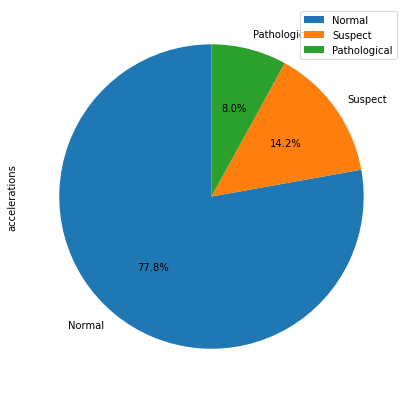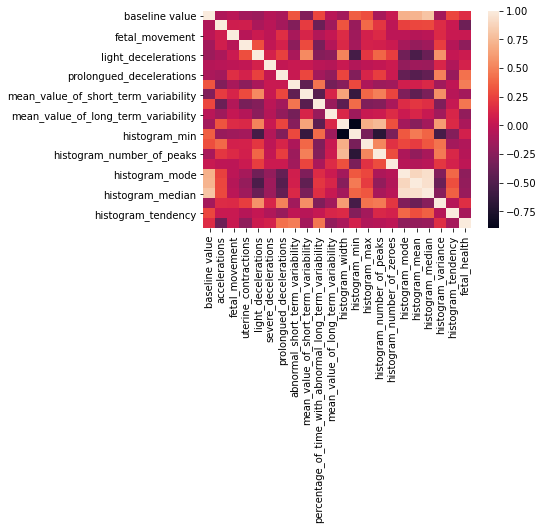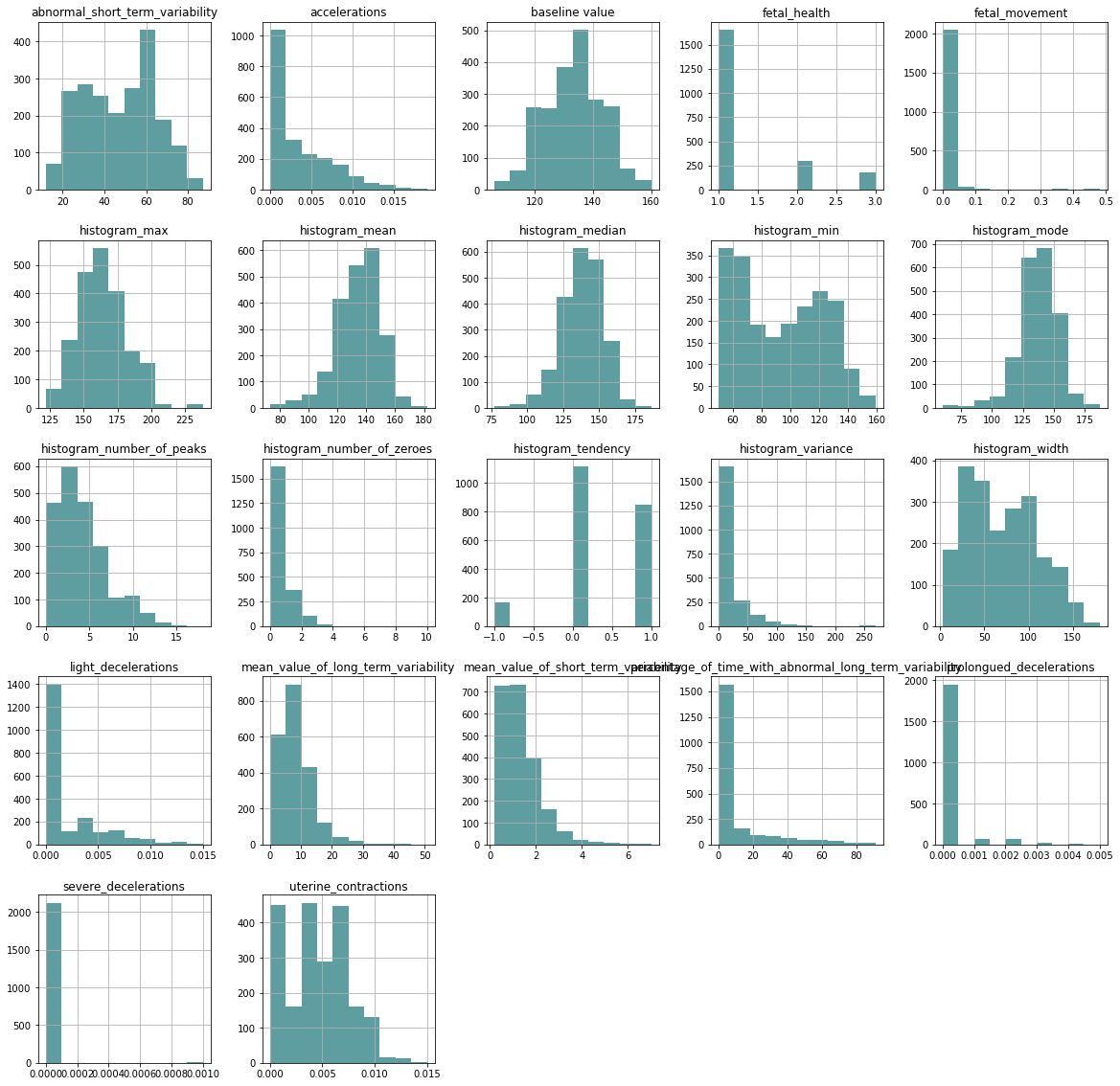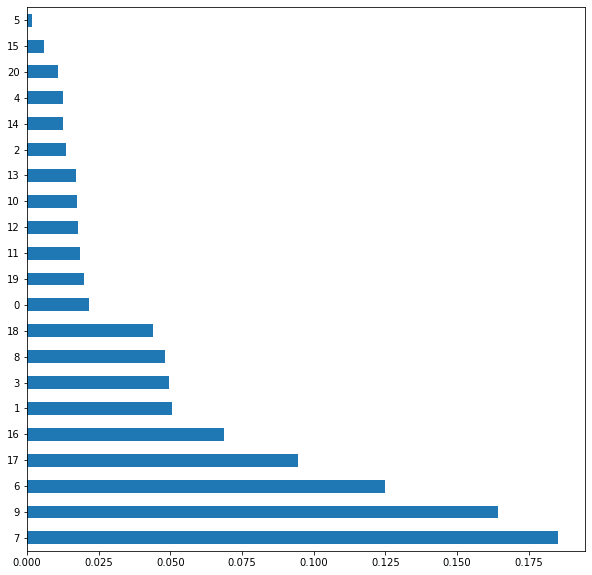Context
Reduction of child mortality is reflected in several of the United Nations’ Sustainable Development Goals and is a key indicator of human progress. The UN expects that by 2030, countries end preventable deaths of newborns and children under 5 years of age, with all countries aiming to reduce under‑5 mortality to at least as low as 25 per 1,000 live births.
Parallel to notion of child mortality is of course maternal mortality, which accounts for 295 000 deaths during and following pregnancy and childbirth (as of 2017). The vast majority of these deaths (94%) occurred in low-resource settings, and most could have been prevented.
In light of what was mentioned above, Cardiotocograms (CTGs) are a simple and cost accessible option to assess fetal health, allowing healthcare professionals to take action in order to prevent child and maternal mortality. The equipment itself works by sending ultrasound pulses and reading its response, thus shedding light on fetal heart rate (FHR), fetal movements, uterine contractions and more.
Project content
- Data Exploration and Visualization
- Data cleaning
- Data Transforming
- Modeling and Hyperparameter tunning
- Unsupervised training
- Evaluation
Target Variable
Let’s talk about our target variable, fetal health. For this project, fetal health was separated into 3 different categories.
- Normal
- Suspect
- Pathological
We will use other variables to try to predict in which category we would include the health of a baby never before seen by the algorithm. Given the importance of the prediction, we will set our goal to develop a tool that has at least a 90% accuracy.
Libraries and packages
import warnings
warnings.simplefilter(action ="ignore")
warnings.filterwarnings('ignore')
# Import the necessary packages
import numpy as np
import pandas as pd
# Data visualization
import matplotlib.pyplot as plt
import seaborn as sns
# Algorithms
from sklearn.model_selection import train_test_split
from sklearn.linear_model import LogisticRegression
from sklearn.neighbors import KNeighborsClassifier
from sklearn.ensemble import RandomForestClassifier
from sklearn.ensemble import GradientBoostingClassifier
from lightgbm import LGBMClassifier
from sklearn.model_selection import RandomizedSearchCV
from sklearn.model_selection import GridSearchCV
from sklearn.metrics import classification_report
Let´s load the dataset
data = pd.read_csv('data/fetal_health.csv')
X = data.drop('fetal_health', axis=1)
y = data['fetal_health']
X_train, X_test, y_train, y_test = train_test_split(
X, y, test_size=0.3, random_state=123)
train = X_train.join(y_train)
Data Exploration, Visualization and Analysis
Exploration
train.head(5)
| baseline value | accelerations | fetal_movement | uterine_contractions | light_decelerations | severe_decelerations | prolongued_decelerations | abnormal_short_term_variability | mean_value_of_short_term_variability | percentage_of_time_with_abnormal_long_term_variability | ... | histogram_min | histogram_max | histogram_number_of_peaks | histogram_number_of_zeroes | histogram_mode | histogram_mean | histogram_median | histogram_variance | histogram_tendency | fetal_health | |
|---|---|---|---|---|---|---|---|---|---|---|---|---|---|---|---|---|---|---|---|---|---|
| 678 | 140.0 | 0.010 | 0.000 | 0.000 | 0.000 | 0.0 | 0.0 | 58.0 | 1.2 | 0.0 | ... | 62.0 | 188.0 | 4.0 | 0.0 | 176.0 | 164.0 | 169.0 | 27.0 | 1.0 | 1.0 |
| 512 | 154.0 | 0.003 | 0.003 | 0.003 | 0.000 | 0.0 | 0.0 | 56.0 | 0.6 | 1.0 | ... | 140.0 | 171.0 | 1.0 | 0.0 | 161.0 | 160.0 | 162.0 | 2.0 | 1.0 | 1.0 |
| 613 | 146.0 | 0.009 | 0.003 | 0.001 | 0.000 | 0.0 | 0.0 | 41.0 | 1.9 | 0.0 | ... | 50.0 | 180.0 | 7.0 | 0.0 | 154.0 | 152.0 | 155.0 | 18.0 | 1.0 | 1.0 |
| 831 | 152.0 | 0.000 | 0.000 | 0.002 | 0.002 | 0.0 | 0.0 | 61.0 | 0.5 | 61.0 | ... | 99.0 | 160.0 | 4.0 | 3.0 | 159.0 | 155.0 | 158.0 | 4.0 | 1.0 | 2.0 |
| 369 | 138.0 | 0.000 | 0.008 | 0.001 | 0.002 | 0.0 | 0.0 | 64.0 | 0.4 | 30.0 | ... | 118.0 | 159.0 | 2.0 | 0.0 | 144.0 | 143.0 | 145.0 | 5.0 | 0.0 | 2.0 |
5 rows × 22 columns
train.info()
<class 'pandas.core.frame.DataFrame'>
Int64Index: 1488 entries, 678 to 1346
Data columns (total 22 columns):
# Column Non-Null Count Dtype
--- ------ -------------- -----
0 baseline value 1488 non-null float64
1 accelerations 1488 non-null float64
2 fetal_movement 1488 non-null float64
3 uterine_contractions 1488 non-null float64
4 light_decelerations 1488 non-null float64
5 severe_decelerations 1488 non-null float64
6 prolongued_decelerations 1488 non-null float64
7 abnormal_short_term_variability 1488 non-null float64
8 mean_value_of_short_term_variability 1488 non-null float64
9 percentage_of_time_with_abnormal_long_term_variability 1488 non-null float64
10 mean_value_of_long_term_variability 1488 non-null float64
11 histogram_width 1488 non-null float64
12 histogram_min 1488 non-null float64
13 histogram_max 1488 non-null float64
14 histogram_number_of_peaks 1488 non-null float64
15 histogram_number_of_zeroes 1488 non-null float64
16 histogram_mode 1488 non-null float64
17 histogram_mean 1488 non-null float64
18 histogram_median 1488 non-null float64
19 histogram_variance 1488 non-null float64
20 histogram_tendency 1488 non-null float64
21 fetal_health 1488 non-null float64
dtypes: float64(22)
memory usage: 307.4 KB
train.describe().T
| count | mean | std | min | 25% | 50% | 75% | max | |
|---|---|---|---|---|---|---|---|---|
| baseline value | 1488.0 | 133.290995 | 9.883484 | 106.0 | 126.000 | 133.000 | 141.000 | 160.000 |
| accelerations | 1488.0 | 0.003185 | 0.003862 | 0.0 | 0.000 | 0.002 | 0.006 | 0.018 |
| fetal_movement | 1488.0 | 0.008259 | 0.042758 | 0.0 | 0.000 | 0.000 | 0.003 | 0.481 |
| uterine_contractions | 1488.0 | 0.004313 | 0.002934 | 0.0 | 0.002 | 0.004 | 0.006 | 0.014 |
| light_decelerations | 1488.0 | 0.001862 | 0.002961 | 0.0 | 0.000 | 0.000 | 0.003 | 0.015 |
| severe_decelerations | 1488.0 | 0.000003 | 0.000052 | 0.0 | 0.000 | 0.000 | 0.000 | 0.001 |
| prolongued_decelerations | 1488.0 | 0.000141 | 0.000535 | 0.0 | 0.000 | 0.000 | 0.000 | 0.005 |
| abnormal_short_term_variability | 1488.0 | 47.096102 | 17.085395 | 12.0 | 32.000 | 49.000 | 61.000 | 87.000 |
| mean_value_of_short_term_variability | 1488.0 | 1.328831 | 0.886662 | 0.2 | 0.700 | 1.200 | 1.700 | 7.000 |
| percentage_of_time_with_abnormal_long_term_variability | 1488.0 | 9.983871 | 18.577807 | 0.0 | 0.000 | 0.000 | 11.000 | 91.000 |
| mean_value_of_long_term_variability | 1488.0 | 8.246438 | 5.693201 | 0.0 | 4.600 | 7.500 | 10.900 | 50.700 |
| histogram_width | 1488.0 | 69.969758 | 39.372667 | 3.0 | 36.000 | 67.000 | 100.250 | 176.000 |
| histogram_min | 1488.0 | 93.774194 | 29.700954 | 50.0 | 67.000 | 93.000 | 120.000 | 155.000 |
| histogram_max | 1488.0 | 163.743952 | 18.140627 | 122.0 | 151.000 | 162.000 | 174.000 | 238.000 |
| histogram_number_of_peaks | 1488.0 | 4.040995 | 3.005767 | 0.0 | 2.000 | 3.000 | 6.000 | 18.000 |
| histogram_number_of_zeroes | 1488.0 | 0.327957 | 0.753364 | 0.0 | 0.000 | 0.000 | 0.000 | 10.000 |
| histogram_mode | 1488.0 | 137.543683 | 16.182615 | 60.0 | 129.000 | 139.000 | 148.000 | 187.000 |
| histogram_mean | 1488.0 | 134.691532 | 15.432030 | 73.0 | 125.000 | 136.000 | 145.000 | 180.000 |
| histogram_median | 1488.0 | 138.201613 | 14.269137 | 79.0 | 129.000 | 139.000 | 148.000 | 183.000 |
| histogram_variance | 1488.0 | 18.342742 | 28.499592 | 0.0 | 2.000 | 7.000 | 23.000 | 269.000 |
| histogram_tendency | 1488.0 | 0.324597 | 0.603854 | -1.0 | 0.000 | 0.000 | 1.000 | 1.000 |
| fetal_health | 1488.0 | 1.301747 | 0.609009 | 1.0 | 1.000 | 1.000 | 1.000 | 3.000 |
Visualization
# Definition of a function to visualize correlation between variables
import seaborn as sn
import matplotlib.pyplot as plt
def plot_correlation(df):
corr_matrix = df.corr()
heat_map = sn.heatmap(corr_matrix, annot=False)
plt.show(heat_map)
Lets visualize first and comprehend the meaning behind our target variable, fetal_health
train.groupby(['fetal_health']).count().plot(kind='pie', y='accelerations', autopct='%1.1f%%',
startangle=90, labels=['Normal', 'Suspect', 'Pathological'], figsize=(7, 7))
<matplotlib.axes._subplots.AxesSubplot at 0x2a5c37cdb20>

In the chart below we can see the correlation between fetal health and the rest of the variables
plot_correlation(train)

In the following comparison, we can see the distribution of data between each variable and fetal health
data_hist_plot = data.hist(figsize = (20,20), color = "#5F9EA0")

Data Cleaning
we will clean the data set of variables that contribute noise to the machine learning algorithm
from sklearn.ensemble import ExtraTreesRegressor
import matplotlib.pyplot as plt
etr_model = ExtraTreesRegressor()
etr_model.fit(X_train, y_train)
feat_importances = pd.Series(etr_model.feature_importances_)
feat_importances.nlargest(30).plot(kind='barh', figsize=(10, 10))
plt.show()

selected_features = etr_model.feature_importances_
selected = [index for index in range(
selected_features.size) if selected_features[index] >= 0.06]
X_train = X_train.iloc[:, selected]
X_test = X_test.iloc[:, selected]
Data Transforming
Now it is time to normalize data, in this case we used MinMaxScaler with a range of 0-1
from sklearn.preprocessing import MinMaxScaler
from sklearn.compose import ColumnTransformer
dif_values = y_train.unique()
# Now we create the transformers
t_norm = ("normalizer", MinMaxScaler(feature_range=(0, 1)), X_train.columns)
column_transformer_X = ColumnTransformer(
transformers=[t_norm], remainder='passthrough')
column_transformer_X.fit(X_train);
X_train = column_transformer_X.transform(X_train)
X_test = column_transformer_X.transform(X_test)
Modeling and Hyperparameter tunning
We will run serveral grid search (some of them randomized to optimize time/performance efficiency)
from sklearn.metrics import make_scorer
from sklearn.pipeline import make_pipeline
from sklearn.pipeline import Pipeline
from sklearn.metrics import accuracy_score
from sklearn.metrics import classification_report
from lightgbm import LGBMClassifier
from sklearn import tree
from sklearn.ensemble import GradientBoostingClassifier
X_val_train, X_val_test, y_val_train, y_val_test = train_test_split(
X_train, y_train, test_size=0.20, random_state=123)
scorer = make_scorer(accuracy_score, greater_is_better=True)
Decision Tree Classifier
pipe_tree = tree.DecisionTreeClassifier(random_state=123)
criteria = ['gini', 'entropy']
splitter = ['best', 'random']
max_depth = [int(x) for x in np.linspace(10, 110, num=22)]
max_features = ['auto', 'sqrt', 'log2', None]
min_samples_split = [2, 5, 10]
min_samples_leaf = [1, 2, 4]
param_grid_tree = {'max_features': max_features,
'max_depth': max_depth,
'min_samples_split': min_samples_split,
'min_samples_leaf': min_samples_leaf,
'criterion': criteria,
'splitter': splitter
}
gs_tree = GridSearchCV(estimator=pipe_tree, param_grid=param_grid_tree,
cv=10, verbose=2, n_jobs=-1)
best_tree = gs_tree.fit(X_val_train, y_val_train)
Fitting 10 folds for each of 3168 candidates, totalling 31680 fits
[Parallel(n_jobs=-1)]: Using backend LokyBackend with 12 concurrent workers.
[Parallel(n_jobs=-1)]: Done 17 tasks | elapsed: 1.3s
[Parallel(n_jobs=-1)]: Done 492 tasks | elapsed: 1.8s
[Parallel(n_jobs=-1)]: Done 20620 tasks | elapsed: 7.3s
[Parallel(n_jobs=-1)]: Done 31680 out of 31680 | elapsed: 9.8s finished
print(classification_report(y_val_test,best_tree.predict(X_val_test)))
precision recall f1-score support
1.0 0.95 0.96 0.96 240
2.0 0.78 0.73 0.75 44
3.0 0.69 0.79 0.73 14
accuracy 0.92 298
macro avg 0.81 0.82 0.81 298
weighted avg 0.92 0.92 0.92 298
print(best_tree.best_params_)
{'criterion': 'gini', 'max_depth': 10, 'max_features': 'auto', 'min_samples_leaf': 2, 'min_samples_split': 5, 'splitter': 'best'}
Logistic regression
pipe_lr = LogisticRegression()
penalty = ['l1', 'l2', 'elasticnet', 'none']
dual = [True, False]
c = np.linspace(0.0001, 10000, num=10)
tol = np.linspace(1e-4, 1e-2, num=10)
fit_intercept = [True, False]
class_weight = ['balanced', None]
solver = ['newton-cg', 'lbfgs', 'liblinear', 'sag', 'saga']
multi_class = ['auto', 'ovr', 'multinomial']
param_grid_lr = {'penalty': penalty,
'dual': dual,
'C': c,
'tol': tol,
'fit_intercept': fit_intercept,
'class_weight': class_weight,
'solver': solver,
'multi_class': multi_class}
gs_lr = GridSearchCV(estimator=pipe_lr, param_grid=param_grid_lr,
cv=10, verbose=2, n_jobs=-1)
gs_lr.fit(X_val_train, y_val_train)
[Parallel(n_jobs=-1)]: Using backend LokyBackend with 12 concurrent workers.
[Parallel(n_jobs=-1)]: Done 17 tasks | elapsed: 0.0s
Fitting 10 folds for each of 48000 candidates, totalling 480000 fits
[Parallel(n_jobs=-1)]: Done 1320 tasks | elapsed: 0.6s
[Parallel(n_jobs=-1)]: Done 14120 tasks | elapsed: 3.8s
[Parallel(n_jobs=-1)]: Done 32232 tasks | elapsed: 12.4s
[Parallel(n_jobs=-1)]: Done 55592 tasks | elapsed: 22.0s
[Parallel(n_jobs=-1)]: Done 73224 tasks | elapsed: 37.5s
[Parallel(n_jobs=-1)]: Done 98172 tasks | elapsed: 52.0s
[Parallel(n_jobs=-1)]: Done 122700 tasks | elapsed: 1.2min
[Parallel(n_jobs=-1)]: Done 164280 tasks | elapsed: 1.6min
[Parallel(n_jobs=-1)]: Done 201336 tasks | elapsed: 2.0min
[Parallel(n_jobs=-1)]: Done 254874 tasks | elapsed: 2.6min
[Parallel(n_jobs=-1)]: Done 298032 tasks | elapsed: 3.0min
[Parallel(n_jobs=-1)]: Done 353130 tasks | elapsed: 3.7min
[Parallel(n_jobs=-1)]: Done 406570 tasks | elapsed: 4.3min
[Parallel(n_jobs=-1)]: Done 469368 tasks | elapsed: 4.9min
[Parallel(n_jobs=-1)]: Done 480000 out of 480000 | elapsed: 5.1min finished
GridSearchCV(cv=10, estimator=LogisticRegression(), n_jobs=-1,
param_grid={'C': array([1.0000000e-04, 1.1111112e+03, 2.2222223e+03, 3.3333334e+03,
4.4444445e+03, 5.5555556e+03, 6.6666667e+03, 7.7777778e+03,
8.8888889e+03, 1.0000000e+04]),
'class_weight': ['balanced', None],
'dual': [True, False], 'fit_intercept': [True, False],
'multi_class': ['auto', 'ovr', 'multinomial'],
'penalty': ['l1', 'l2', 'elasticnet', 'none'],
'solver': ['newton-cg', 'lbfgs', 'liblinear', 'sag',
'saga'],
'tol': array([0.0001, 0.0012, 0.0023, 0.0034, 0.0045, 0.0056, 0.0067, 0.0078,
0.0089, 0.01 ])},
verbose=2)
print(classification_report(gs_lr.best_estimator_.predict(X_val_test), y_val_test))
precision recall f1-score support
1.0 0.95 0.93 0.94 247
2.0 0.57 0.74 0.64 34
3.0 0.86 0.71 0.77 17
accuracy 0.89 298
macro avg 0.79 0.79 0.79 298
weighted avg 0.90 0.89 0.90 298
print(gs_lr.best_params_)
{'C': 5555.555600000001, 'class_weight': None, 'dual': False, 'fit_intercept': True, 'multi_class': 'multinomial', 'penalty': 'none', 'solver': 'sag', 'tol': 0.0089}
Gradient Boosting Classifier
pipe_gbc = GradientBoostingClassifier(random_state=123)
learning_rate = np.linspace(0.001, 1, num=10)
n_estimators = [50, 100, 200, 500]
criteria = ['friedman_mse', 'mse', 'mae']
min_samples_split = np.linspace(0, 20, num=10, dtype=int)
min_samples_leaf = np.linspace(1e-2, 0.5, num=10)
np.append(min_samples_leaf, int(1))
min_weight_fraction_leaf = [0, 1]
max_depth = np.arange(1, 21, 2)
max_features = ['auto', 'sqrt', 'log2']
param_grid_gbc = {'learning_rate': learning_rate,
'n_estimators': n_estimators,
'criterion': criteria,
'min_samples_split': min_samples_split,
'min_samples_leaf': min_samples_leaf,
'min_weight_fraction_leaf': min_weight_fraction_leaf,
'max_depth': max_depth,
'max_features': max_features}
gs_gbc = RandomizedSearchCV(estimator=pipe_gbc, param_distributions=param_grid_gbc, n_iter=350,
cv=10, verbose=2, n_jobs=-1)
gs_gbc.fit(X_val_train, y_val_train)
Fitting 10 folds for each of 350 candidates, totalling 3500 fits
[Parallel(n_jobs=-1)]: Using backend LokyBackend with 12 concurrent workers.
[Parallel(n_jobs=-1)]: Done 17 tasks | elapsed: 2.7s
[Parallel(n_jobs=-1)]: Done 138 tasks | elapsed: 17.9s
[Parallel(n_jobs=-1)]: Done 341 tasks | elapsed: 50.2s
[Parallel(n_jobs=-1)]: Done 788 tasks | elapsed: 1.2min
[Parallel(n_jobs=-1)]: Done 1472 tasks | elapsed: 2.1min
[Parallel(n_jobs=-1)]: Done 2141 tasks | elapsed: 3.5min
[Parallel(n_jobs=-1)]: Done 3012 tasks | elapsed: 4.9min
[Parallel(n_jobs=-1)]: Done 3500 out of 3500 | elapsed: 5.8min finished
RandomizedSearchCV(cv=10,
estimator=GradientBoostingClassifier(random_state=123),
n_iter=350, n_jobs=-1,
param_distributions={'criterion': ['friedman_mse', 'mse',
'mae'],
'learning_rate': array([0.001, 0.112, 0.223, 0.334, 0.445, 0.556, 0.667, 0.778, 0.889,
1. ]),
'max_depth': array([ 1, 3, 5, 7, 9, 11, 13, 15, 17, 19]),
'max_features': ['auto', 'sqrt',
'log2'],
'min_samples_leaf': array([0.01 , 0.06444444, 0.11888889, 0.17333333, 0.22777778,
0.28222222, 0.33666667, 0.39111111, 0.44555556, 0.5 ]),
'min_samples_split': array([ 0, 2, 4, 6, 8, 11, 13, 15, 17, 20]),
'min_weight_fraction_leaf': [0, 1],
'n_estimators': [50, 100, 200, 500]},
verbose=2)
print(classification_report(y_val_test, gs_gbc.predict(X_val_test)))
precision recall f1-score support
1.0 0.96 0.95 0.96 240
2.0 0.77 0.75 0.76 44
3.0 0.76 0.93 0.84 14
accuracy 0.92 298
macro avg 0.83 0.88 0.85 298
weighted avg 0.92 0.92 0.92 298
print(gs_gbc.best_params_)
{'n_estimators': 50, 'min_weight_fraction_leaf': 0, 'min_samples_split': 11, 'min_samples_leaf': 0.01, 'max_features': 'auto', 'max_depth': 3, 'learning_rate': 0.223, 'criterion': 'friedman_mse'}
LightGBM Classifier
pipe_light = LGBMClassifier(random_state=123)
n_estimators = [int(x) for x in np.linspace(start=200, stop=2000, num=10)]
max_features = ['auto', 'sqrt']
max_depth = [int(x) for x in np.linspace(10, 110, num=11)]
bootstrap = [True, False]
param_grid_light = {'n_estimators': n_estimators,
'max_features': max_features,
'max_depth': max_depth,
'bootstrap': bootstrap
}
gs_light = GridSearchCV(estimator=pipe_light, param_grid=param_grid_light, cv=5, verbose=2, n_jobs=-1)
gs_light.fit(X_val_train, y_val_train);
Fitting 5 folds for each of 440 candidates, totalling 2200 fits
[Parallel(n_jobs=-1)]: Using backend LokyBackend with 12 concurrent workers.
[Parallel(n_jobs=-1)]: Done 17 tasks | elapsed: 1.3s
[Parallel(n_jobs=-1)]: Done 138 tasks | elapsed: 11.8s
[Parallel(n_jobs=-1)]: Done 341 tasks | elapsed: 28.8s
[Parallel(n_jobs=-1)]: Done 624 tasks | elapsed: 52.2s
[Parallel(n_jobs=-1)]: Done 989 tasks | elapsed: 1.4min
[Parallel(n_jobs=-1)]: Done 1434 tasks | elapsed: 2.0min
[Parallel(n_jobs=-1)]: Done 1961 tasks | elapsed: 2.7min
[Parallel(n_jobs=-1)]: Done 2200 out of 2200 | elapsed: 3.1min finished
[LightGBM] [Warning] Unknown parameter: bootstrap
[LightGBM] [Warning] Unknown parameter: max_features
[LightGBM] [Warning] Accuracy may be bad since you didn't explicitly set num_leaves OR 2^max_depth > num_leaves. (num_leaves=31).
print(classification_report(y_val_test, gs_light.predict(X_val_test)))
precision recall f1-score support
1.0 0.95 0.96 0.96 240
2.0 0.79 0.70 0.75 44
3.0 0.72 0.93 0.81 14
accuracy 0.92 298
macro avg 0.82 0.86 0.84 298
weighted avg 0.92 0.92 0.92 298
print(gs_light.best_params_)
{'bootstrap': True, 'max_depth': 30, 'max_features': 'auto', 'n_estimators': 200}
Random Forest
n_estimators = [int(x) for x in np.linspace(start=200, stop=2000, num=10)]
max_features = ['auto', 'sqrt']
max_depth = [int(x) for x in np.linspace(10, 110, num=11)]
min_samples_split = [2, 5, 10]
min_samples_leaf = [1, 2, 4]
bootstrap = [True, False]
random_grid = {'n_estimators': n_estimators,
'max_features': max_features,
'max_depth': max_depth,
'min_samples_split': min_samples_split,
'min_samples_leaf': min_samples_leaf,
'bootstrap': bootstrap}
rf = RandomForestClassifier(random_state=123)
gs_rf = RandomizedSearchCV(estimator=rf, param_distributions=random_grid,
n_iter=100, cv=10, verbose=2, random_state=123, n_jobs=-1)
gs_rf.fit(X_val_train, y_val_train);
Fitting 10 folds for each of 100 candidates, totalling 1000 fits
[Parallel(n_jobs=-1)]: Using backend LokyBackend with 12 concurrent workers.
[Parallel(n_jobs=-1)]: Done 17 tasks | elapsed: 7.4s
[Parallel(n_jobs=-1)]: Done 138 tasks | elapsed: 33.3s
[Parallel(n_jobs=-1)]: Done 341 tasks | elapsed: 1.2min
[Parallel(n_jobs=-1)]: Done 624 tasks | elapsed: 2.0min
[Parallel(n_jobs=-1)]: Done 1000 out of 1000 | elapsed: 3.2min finished
print(classification_report(y_val_test, gs_rf.predict(X_val_test)))
precision recall f1-score support
1.0 0.95 0.97 0.96 240
2.0 0.84 0.70 0.77 44
3.0 0.87 0.93 0.90 14
accuracy 0.93 298
macro avg 0.88 0.87 0.87 298
weighted avg 0.93 0.93 0.93 298
print(gs_rf.best_params_)
{'n_estimators': 800, 'min_samples_split': 5, 'min_samples_leaf': 2, 'max_features': 'auto', 'max_depth': 10, 'bootstrap': True}
Modeling Conclusion
We concluded that random forest was the model that had the best performance overall.
Unsupervised training
Now that we found our best model, we will try adding some clusters that could help classify easier our target variables.
from sklearn.cluster import KMeans
kmeans = KMeans(
n_clusters=3,
random_state=123
).fit(X_val_train)
test_cluster = kmeans.predict(X_val_test)
X_val_train = np.append(X_val_train, np.expand_dims(kmeans.labels_, axis=1), axis=1)
X_val_test = np.append(X_val_test, np.expand_dims(test_cluster, axis=1), axis=1)
best_rf = rf = RandomForestClassifier(random_state=123, n_estimators=800, min_samples_split=5,
min_samples_leaf=2, max_features='auto', max_depth=10, bootstrap=True)
best_rf.fit(X_val_train, y_val_train)
RandomForestClassifier(max_depth=10, min_samples_leaf=2, min_samples_split=5,
n_estimators=800, random_state=123)
print(classification_report(y_val_test,best_rf.predict(X_val_test)))
precision recall f1-score support
1.0 0.95 0.97 0.96 240
2.0 0.84 0.70 0.77 44
3.0 0.87 0.93 0.90 14
accuracy 0.93 298
macro avg 0.88 0.87 0.87 298
weighted avg 0.93 0.93 0.93 298
it seems that no metrics changed, so we will not include the clusters to avoid any noise in the algorithm
Evaluation
We will recreate the best model, but this time we will train it with all the data from the train set.
best_rf = rf = RandomForestClassifier(random_state=123, n_estimators=800, min_samples_split=5,
min_samples_leaf=2, max_features='auto', max_depth=10, bootstrap=True)
best_rf.fit(X_train, y_train)
RandomForestClassifier(max_depth=10, min_samples_leaf=2, min_samples_split=5,
n_estimators=800, random_state=123)
print(classification_report(y_test,best_rf.predict(X_test)))
precision recall f1-score support
1.0 0.95 0.95 0.95 497
2.0 0.76 0.74 0.75 84
3.0 0.83 0.86 0.84 57
accuracy 0.92 638
macro avg 0.85 0.85 0.85 638
weighted avg 0.92 0.92 0.92 638
Conclusion
We have developed a tool that predicts with 92% accuracy in which category we would place the health of a fetus. Since our goal was set to reach 90%, we can conclude that this project was successfully resolved.